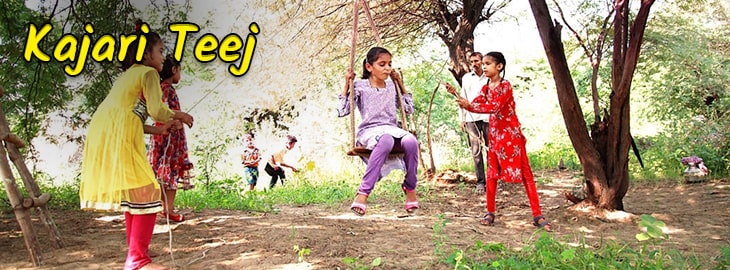Kajari Teej, also known by the name Kajali Teej, is celebrated on the third day of the Krishna Paksha (dark fortnight) during the lunar month of Bhadrapada. According to the Gregorian Panchang, the day falls during the months of July or August. Kajri Teej is primarily a festival of ladies. It is celebrated in Madhya Pradesh, Uttar Pradesh, Rajasthan and other parts of the country. The festival is also known as Boodhi Teej and Satudi Teej in some region. Like Hartalika Teej and Hariyali Teej, Kajari Teej also holds an immense significance for married women. A fast observed on the day of Kajari Teej leads to happiness and bliss in married life.
Rituals for Kajari Teej
The festival is celebrated with delight and zeal by women. While some regions add their own touch to the festival, the basic rituals which are followed remain the same. These rituals for Kajari Teej are listed below:
- Married women observe fast on this day for the longevity of their husbands, while unmarried girls comply this fast in order to be blessed with a good husband.
- On the day of Kajali Teej, several dishes are prepared using wheat, barley, gram and rice mixture (sattu). The fast is concluded when the observer sees the moon.
- The worship of cows is a significant facet of Kajari Teej. Small chapattis made up of wheat flour, coated with jaggery and ghee is first fed to the holy cows, and then the food is consumed.
- The ladies celebrate the day by adorning their houses with beautiful swings, and dance to the tunes of folk-songs.
- One significant feature of the day is Kajari Teej songs. The people of Bihar and Uttar Pradesh sing Kajari songs accompany by the beats of drums.
Pooja Vidhi for Kajari Teej
Goddess Neemdi, also known as Neemdi Mata is linked with this holy festival. The worship of Goddess Neemdi is performing with devotion on the day of Kajari Teej. Before performing the pooja, there is a ritual of making a pond-like structure using the support of a wall. Pure ghee and jaggery are used to make stronger and decorate the outer borders of this structure, and a twig of Neem is planted near it. Raw milk and water are poured inside the pond, and a lamp (diya) is lit and kept near it. The Pooja thali (plate) is adorned with lemon, bananas, cucumber, apples, Sattu, sacred thread, vermillion, whole rice, etc. Raw milk is taken in a vessel, and in the evening worship of the Goddess should be done according to the rituals (Puja Vidhi) given in the following points:
- Along with perfusion water and vermillion (sindoor), rice is offered to Goddess Neemdi.
- On the wall behind the Goddess, 13 dots are marked using vermillion, henna, and black kohl each. The dots of henna and vermillion are made by using the little finger, while the 13 dots of kohl are marked with the ring finger.
- After offering the holy thread, Goddess Neemdi is also offered kohl, henna, and clothes. The wall is embellished with the pious thread by using the dots marked on it.
- Offer fruits or other oblations to Goddess Neemdi. Apply a Tilak of vermilion on the Pooja Kalash (sacred vessel), and tie the pious thread around it.
- In the light of the lamp (diya) placed near the pond; one should look at the cucumber, neem twig, lemon, nose pin, etc. After this, offer Arghya to the Moon God.
Rituals for offering Arghya to Moon God
After worshipping Goddess Neemdi in the evening, Arghya (mixture of milk and water) is offered to the Moon God as a part of Kajari Teej rituals.
- After sprinkling some drops of water, vermillion, pious thread and whole rice are offered, along with food oblations to the Moon God.
- Holding a silver ring and wheat grains in your hand, offer Arghya to the Moon God. Make sure that you stay at the same place and rotate four times in a clockwise direction (Pradakshina).
Kajari Teej Vrat Rituals
- Commonly, the observers of the fast choose not to even drink water during the fast (Nirjala). Although, pregnant women are allowed to eat fruits during the fast.
- If by any means, the observer is not able to see the Moon, the fast must be broken by looking at the sky at 11:30 P.M., and consuming food.
- After Udyapan (rituals for ending a fast), if a proper Nirjala fast is not possible the observer can eat fruits during the fast.
If perform accordingly and with unfathomable devotion, the fast can ensure a happy married life for the observers in the long run.



